fuel pressure FIAT SCUDO 2016 Owner handbook (in English)
[x] Cancel search | Manufacturer: FIAT, Model Year: 2016, Model line: SCUDO, Model: FIAT SCUDO 2016Pages: 227, PDF Size: 4.46 MB
Page 94 of 227
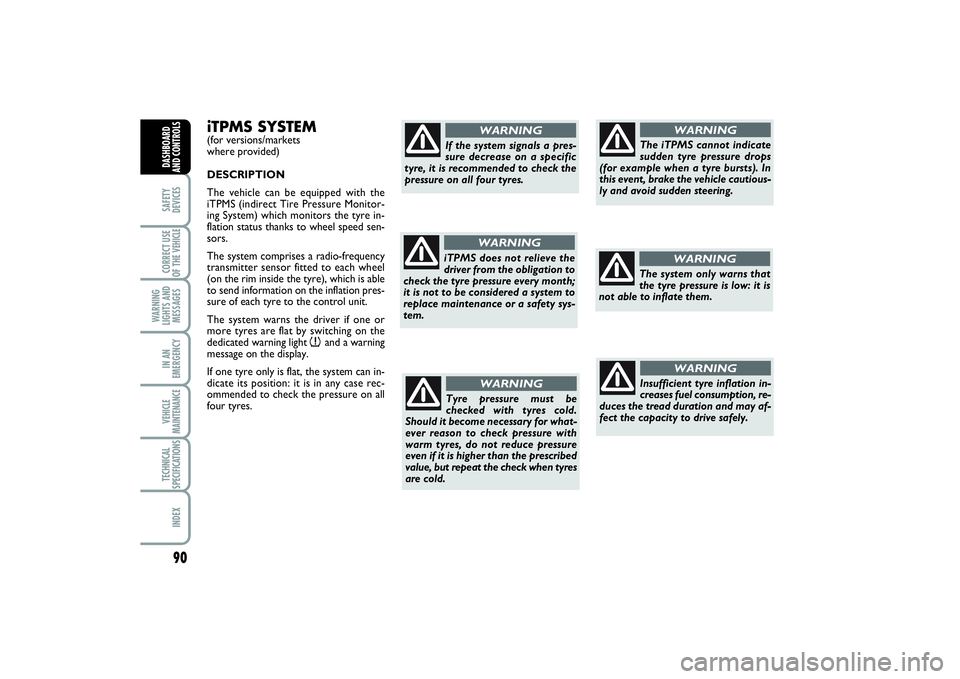
90SAFETY
DEVICESCORRECT USE
OF THE VEHICLE
WARNING
LIGHTS AND
MESSAGESIN AN
EMERGENCYVEHICLE
MAINTENANCETECHNICAL
SPECIFICATIONSINDEXDASHBOARD
AND CONTROLS
iTPMS SYSTEM(for versions/markets
where provided)
DESCRIPTION
The vehicle can be equipped with the
iTPMS (indirect Tire Pressure Monitor-
ing System) which monitors the tyre in-
flation status thanks to wheel speed sen-
sors.
The system comprises a radio-frequency
transmitter sensor fitted to each wheel
(on the rim inside the tyre), which is able
to send information on the inflation pres-
sure of each tyre to the control unit.
The system warns the driver if one or
more tyres are flat by switching on the
dedicated warning light
n
and a warning
message on the display.
If one tyre only is flat, the system can in-
dicate its position: it is in any case rec-
ommended to check the pressure on all
four tyres.
WARNING
If the system signals a pres-
sure decrease on a specific
tyre, it is recommended to check the
pressure on all four tyres.
WARNING
iTPMS does not relieve the
driver from the obligation to
check the tyre pressure every month;
it is not to be considered a system to
replace maintenance or a safety sys-
tem.
WARNING
Tyre pressure must be
checked with tyres cold.
Should it become necessary for what-
ever reason to check pressure with
warm tyres, do not reduce pressure
even if it is higher than the prescribed
value, but repeat the check when tyres
are cold.
WARNING
The iTPMS cannot indicate
sudden tyre pressure drops
(for example when a tyre bursts). In
this event, brake the vehicle cautious-
ly and avoid sudden steering.
WARNING
The system only warns that
the tyre pressure is low: it is
not able to inflate them.
WARNING
Insufficient tyre inflation in-
creases fuel consumption, re-
duces the tread duration and may af-
fect the capacity to drive safely.
083-096 SCUDO LUM GB 27/03/14 10:22 Pagina 90
Page 95 of 227
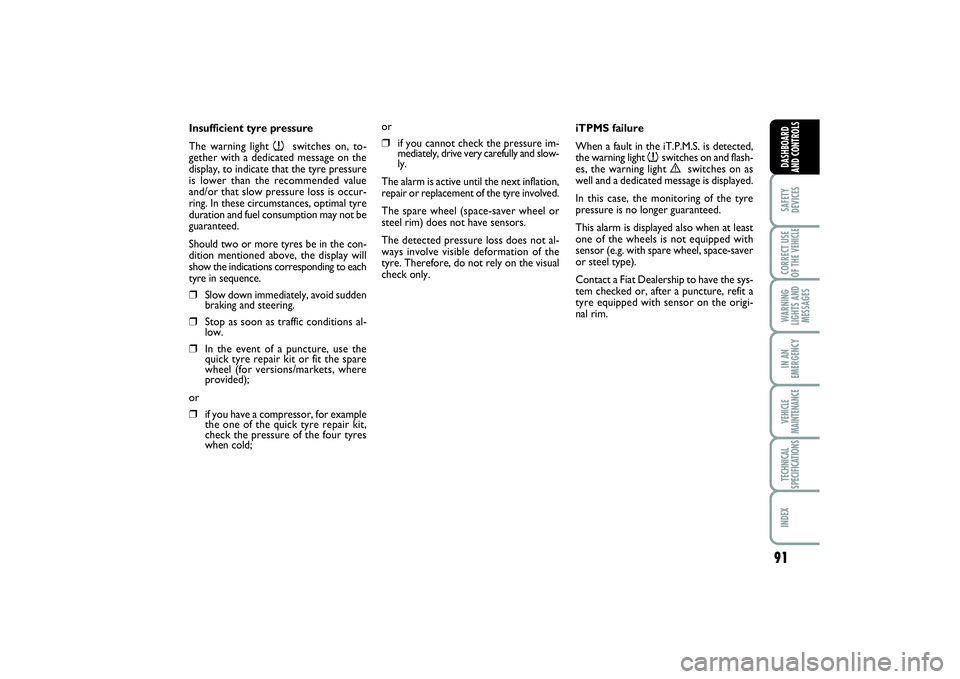
91
SAFETY
DEVICESCORRECT USE
OF THE VEHICLE WARNING
LIGHTS AND
MESSAGESIN AN
EMERGENCYVEHICLE
MAINTENANCETECHNICAL
SPECIFICATIONSINDEX DASHBOARD
AND CONTROLS
Insufficient tyre pressure
The warning light
n
switches on, to-
gether with a dedicated message on the
display, to indicate that the tyre pressure
is lower than the recommended value
and/or that slow pressure loss is occur-
ring. In these circumstances, optimal tyre
duration and fuel consumption may not be
guaranteed.
Should two or more tyres be in the con-
dition mentioned above, the display will
show the indications corresponding to each
tyre in sequence.
❒
Slow down immediately, avoid sudden
braking and steering.
❒
Stop as soon as traffic conditions al-
low.
❒
In the event of a puncture, use the
quick tyre repair kit or fit the spare
wheel (for versions/markets, where
provided);
or
❒
if you have a compressor, for example
the one of the quick tyre repair kit,
check the pressure of the four tyres
when cold;or
❒
if you cannot check the pressure im-
mediately, drive very carefully and slow-
ly.
The alarm is active until the next inflation,
repair or replacement of the tyre involved.
The spare wheel (space-saver wheel or
steel rim) does not have sensors.
The detected pressure loss does not al-
ways involve visible deformation of the
tyre. Therefore, do not rely on the visual
check only.iTPMS failure
When a fault in the iT.P.M.S. is detected,
the warning light
n
switches on and flash-
es, the warning light è
switches on as
well and a dedicated message is displayed.
In this case, the monitoring of the tyre
pressure is no longer guaranteed.
This alarm is displayed also when at least
one of the wheels is not equipped with
sensor (e.g. with spare wheel, space-saver
or steel type).
Contact a Fiat Dealership to have the sys-
tem checked or, after a puncture, refit a
tyre equipped with sensor on the origi-
nal rim.
083-096 SCUDO LUM GB 27/03/14 10:22 Pagina 91
Page 128 of 227
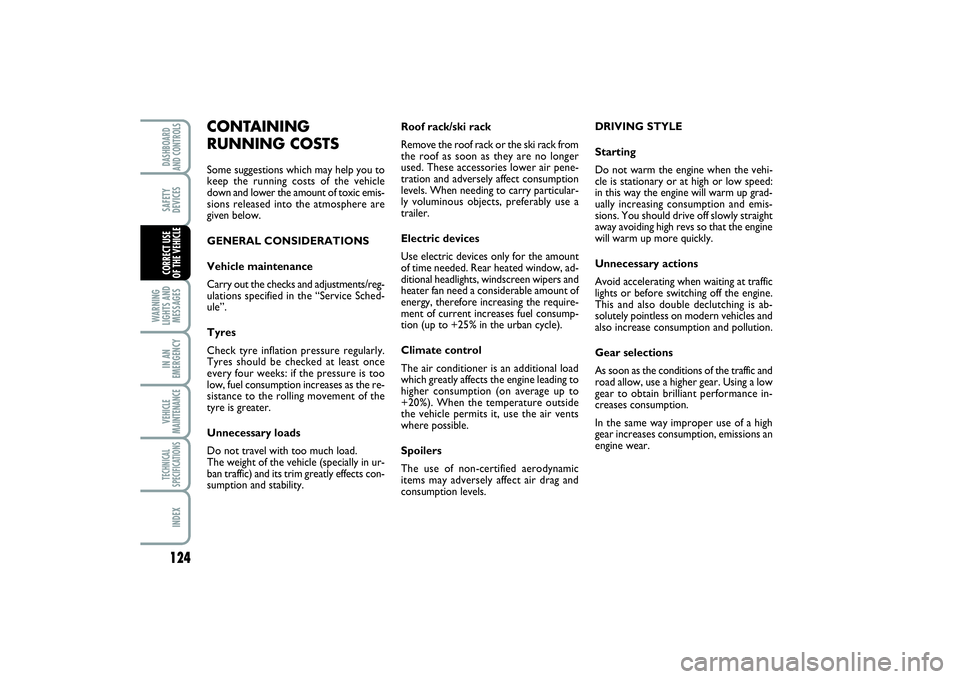
124WARNING
LIGHTS AND
MESSAGESIN AN
EMERGENCYVEHICLE
MAINTENANCETECHNICAL
SPECIFICATIONSINDEXDASHBOARD
AND CONTROLSSAFETY
DEVICESCORRECT USE
OF THE VEHICLE
Roof rack/ski rack
Remove the roof rack or the ski rack from
the roof as soon as they are no longer
used. These accessories lower air pene-
tration and adversely affect consumption
levels. When needing to carry particular-
ly voluminous objects, preferably use a
trailer.
Electric devices
Use electric devices only for the amount
of time needed. Rear heated window, ad-
ditional headlights, windscreen wipers and
heater fan need a considerable amount of
energy, therefore increasing the require-
ment of current increases fuel consump-
tion (up to +25% in the urban cycle).
Climate control
The air conditioner is an additional load
which greatly affects the engine leading to
higher consumption (on average up to
+20%). When the temperature outside
the vehicle permits it, use the air vents
where possible.
Spoilers
The use of non-certified aerodynamic
items may adversely affect air drag and
consumption levels.DRIVING STYLE
Starting
Do not warm the engine when the vehi-
cle is stationary or at high or low speed:
in this way the engine will warm up grad-
ually increasing consumption and emis-
sions. You should drive off slowly straight
away avoiding high revs so that the engine
will warm up more quickly.
Unnecessary actions
Avoid accelerating when waiting at traffic
lights or before switching off the engine.
This and also double declutching is ab-
solutely pointless on modern vehicles and
also increase consumption and pollution.
Gear selections
As soon as the conditions of the traffic and
road allow, use a higher gear. Using a low
gear to obtain brilliant performance in-
creases consumption.
In the same way improper use of a high
gear increases consumption, emissions an
engine wear.
CONTAINING
RUNNING COSTSSome suggestions which may help you to
keep the running costs of the vehicle
down and lower the amount of toxic emis-
sions released into the atmosphere are
given below.
GENERAL CONSIDERATIONS
Vehicle maintenance
Carry out the checks and adjustments/reg-
ulations specified in the “Service Sched-
ule”.
Tyres
Check tyre inflation pressure regularly.
Tyres should be checked at least once
every four weeks: if the pressure is too
low, fuel consumption increases as the re-
sistance to the rolling movement of the
tyre is greater.
Unnecessary loads
Do not travel with too much load.
The weight of the vehicle (specially in ur-
ban traffic) and its trim greatly effects con-
sumption and stability.
119-128 SCUDO LUM GB 18/11/13 14.26 Pagina 124
Page 133 of 227
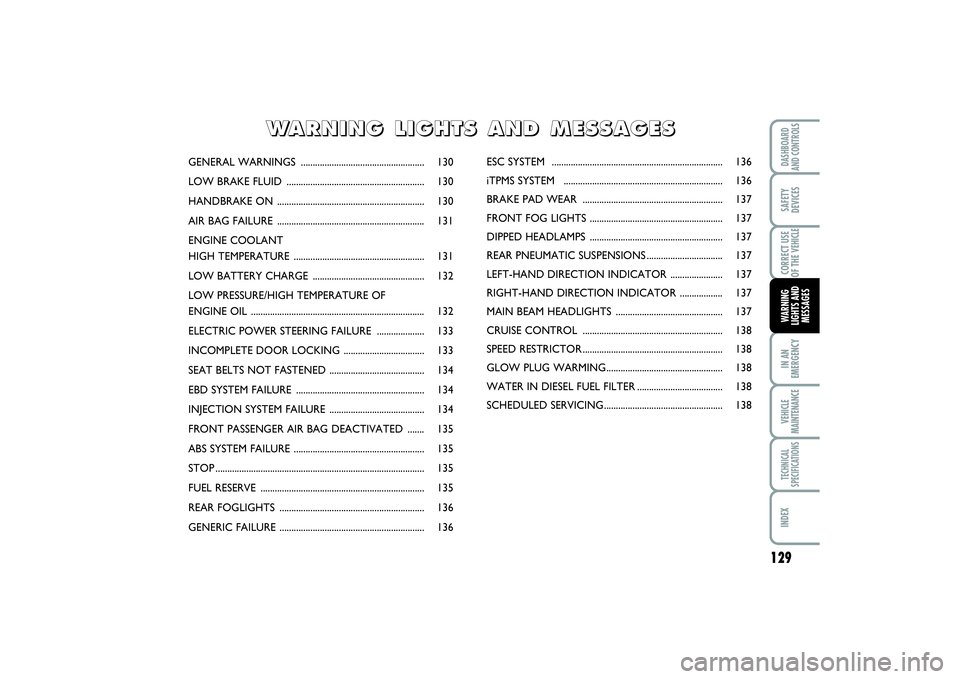
129
IN AN
EMERGENCYVEHICLE
MAINTENANCETECHNICAL
SPECIFICATIONSINDEXDASHBOARD
AND CONTROLSSAFETY
DEVICESCORRECT USE
OF THE VEHICLEWARNING
LIGHTS AND
MESSAGES
GENERAL WARNINGS .................................................... 130
LOW BRAKE FLUID .......................................................... 130
HANDBRAKE ON .............................................................. 130
AIR BAG FAILURE .............................................................. 131
ENGINE COOLANT
HIGH TEMPERATURE ....................................................... 131
LOW BATTERY CHARGE ............................................... 132
LOW PRESSURE/HIGH TEMPERATURE OF
ENGINE OIL ......................................................................... 132
ELECTRIC POWER STEERING FAILURE .................... 133
INCOMPLETE DOOR LOCKING .................................. 133
SEAT BELTS NOT FASTENED ........................................ 134
EBD SYSTEM FAILURE ...................................................... 134
INJECTION SYSTEM FAILURE ........................................ 134
FRONT PASSENGER AIR BAG DEACTIVATED ....... 135
ABS SYSTEM FAILURE ....................................................... 135
STOP ........................................................................................ 135
FUEL RESERVE ..................................................................... 135
REAR FOGLIGHTS ............................................................. 136
GENERIC FAILURE ............................................................. 136ESC SYSTEM ........................................................................ 136
iTPMS SYSTEM ................................................................... 136
BRAKE PAD WEAR ........................................................... 137
FRONT FOG LIGHTS ........................................................ 137
DIPPED HEADLAMPS ........................................................ 137
REAR PNEUMATIC SUSPENSIONS ................................ 137
LEFT-HAND DIRECTION INDICATOR ...................... 137
RIGHT-HAND DIRECTION INDICATOR .................. 137
MAIN BEAM HEADLIGHTS ............................................. 137
CRUISE CONTROL ........................................................... 138
SPEED RESTRICTOR ........................................................... 138
GLOW PLUG WARMING................................................. 138
WATER IN DIESEL FUEL FILTER .................................... 138
SCHEDULED SERVICING.................................................. 138
W W
A A
R R
N N
I I
N N
G G
L L
I I
G G
H H
T T
S S
A A
N N
D D
M M
E E
S S
S S
A A
G G
E E
S S
129-138 SCUDO LUM GB 27/03/14 11:47 Pagina 129
Page 140 of 227
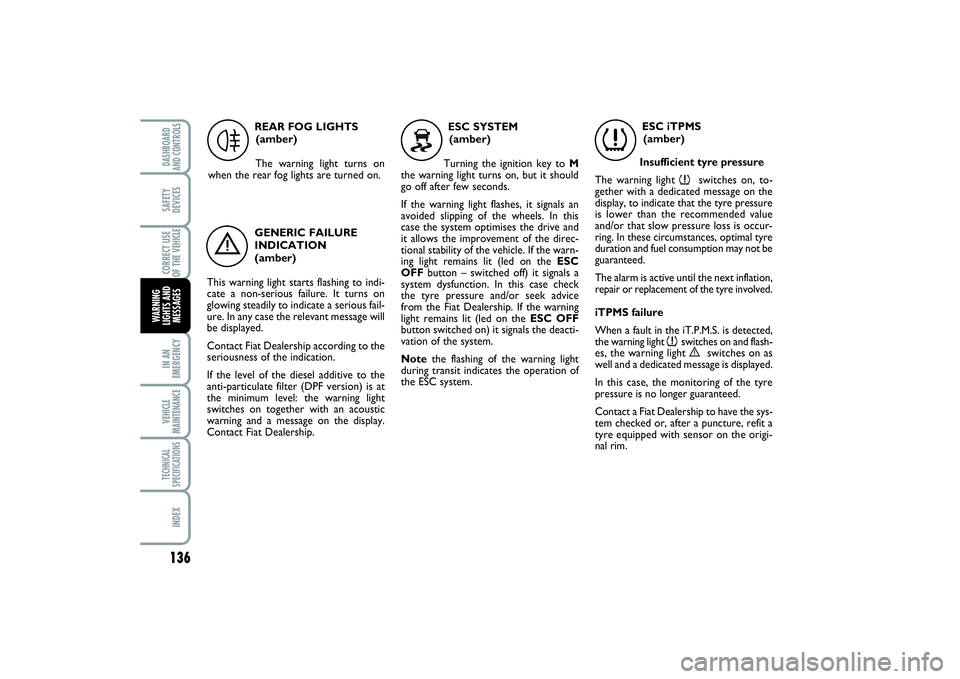
136IN AN
EMERGENCYVEHICLE
MAINTENANCETECHNICAL
SPECIFICATIONSINDEXDASHBOARD
AND CONTROLSSAFETY
DEVICESCORRECT USE
OF THE VEHICLE
WARNING
LIGHTS AND
MESSAGES
REAR FOG LIGHTS
(amber)
The warning light turns on
when the rear fog lights are turned on.
4
GENERIC FAILURE
INDICATION
(amber)
This warning light starts flashing to indi-
cate a non-serious failure. It turns on
glowing steadily to indicate a serious fail-
ure. In any case the relevant message will
be displayed.
Contact Fiat Dealership according to the
seriousness of the indication.
If the level of the diesel additive to the
anti-particulate filter (DPF version) is at
the minimum level: the warning light
switches on together with an acoustic
warning and a message on the display.
Contact Fiat Dealership.
è
ESC SYSTEM
(amber)
Turning the ignition key to M
the warning light turns on, but it should
go off after few seconds.
If the warning light flashes, it signals an
avoided slipping of the wheels. In this
case the system optimises the drive and
it allows the improvement of the direc-
tional stability of the vehicle. If the warn-
ing light remains lit (led on the ESC
OFFbutton – switched off) it signals a
system dysfunction. In this case check
the tyre pressure and/or seek advice
from the Fiat Dealership. If the warning
light remains lit (led on the ESC OFF
button switched on) it signals the deacti-
vation of the system.
Notethe flashing of the warning light
during transit indicates the operation of
the ESC system.
ESC iTPMS
(amber)
Insufficient tyre pressure
The warning light
n
switches on, to-
gether with a dedicated message on the
display, to indicate that the tyre pressure
is lower than the recommended value
and/or that slow pressure loss is occur-
ring. In these circumstances, optimal tyre
duration and fuel consumption may not be
guaranteed.
The alarm is active until the next inflation,
repair or replacement of the tyre involved.
iTPMS failure
When a fault in the iT.P.M.S. is detected,
the warning light
n
switches on and flash-
es, the warning light è
switches on as
well and a dedicated message is displayed.
In this case, the monitoring of the tyre
pressure is no longer guaranteed.
Contact a Fiat Dealership to have the sys-
tem checked or, after a puncture, refit a
tyre equipped with sensor on the origi-
nal rim.
n
129-138 SCUDO LUM GB 27/03/14 11:47 Pagina 136
Page 165 of 227
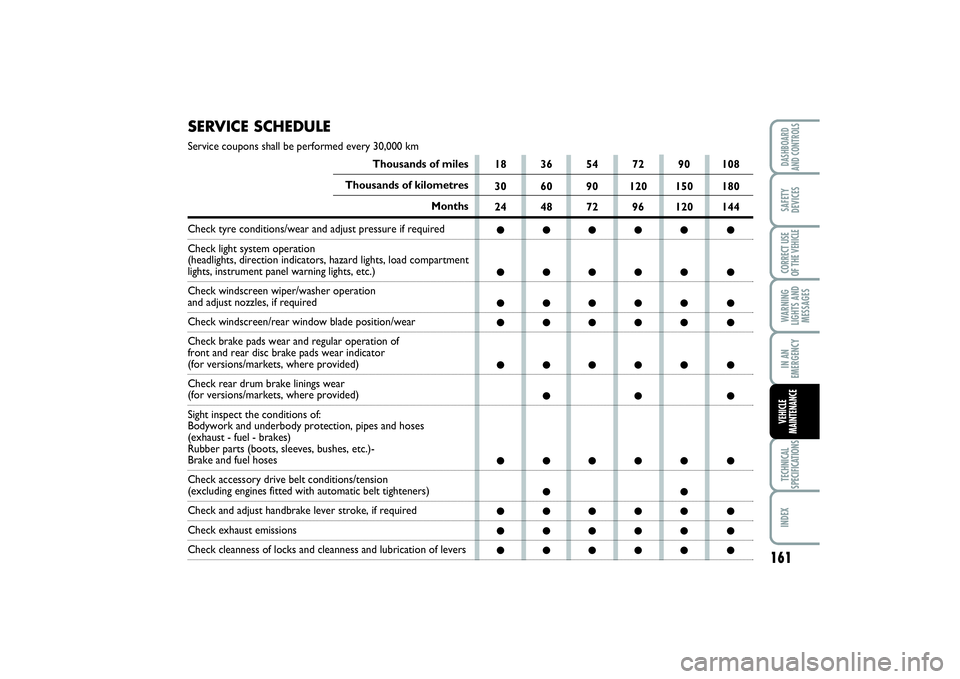
161
WARNING
LIGHTS AND
MESSAGESTECHNICAL
SPECIFICATIONSINDEX DASHBOARD
AND CONTROLSSAFETY
DEVICESCORRECT USE
OF THE VEHICLEIN AN
EMERGENCYVEHICLE
MAINTENANCE
18 36 54 72 90 108
30 60 90 120 150 180
24 48 72 96 120 144●●●●● ●
●●●●● ●
●●●●● ●
●●●●● ●
●●●●● ●
●● ●
●●●●● ●
●●
●●●●● ●
●●●●● ●
●●●●● ●
SERVICE SCHEDULEService coupons shall be performed every 30,000 km
Thousands of miles
Thousands of kilometres
Months
Check tyre conditions/wear and adjust pressure if required
Check light system operation
(headlights, direction indicators, hazard lights, load compartment lights, instrument panel warning lights, etc.)
Check windscreen wiper/washer operation and adjust nozzles, if requiredCheck windscreen/rear window blade position/wear
Check brake pads wear and regular operation of
front and rear disc brake pads wear indicator (for versions/markets, where provided)
Check rear drum brake linings wear (for versions/markets, where provided)
Sight inspect the conditions of:
Bodywork and underbody protection, pipes and hoses
(exhaust - fuel - brakes)
Rubber parts (boots, sleeves, bushes, etc.)-Brake and fuel hoses
Check accessory drive belt conditions/tension (excluding engines fitted with automatic belt tighteners)Check and adjust handbrake lever stroke, if requiredCheck exhaust emissionsCheck cleanness of locks and cleanness and lubrication of levers
159-178 SCUDO LUM GB 12/12/13 10.02 Pagina 161
Page 167 of 227
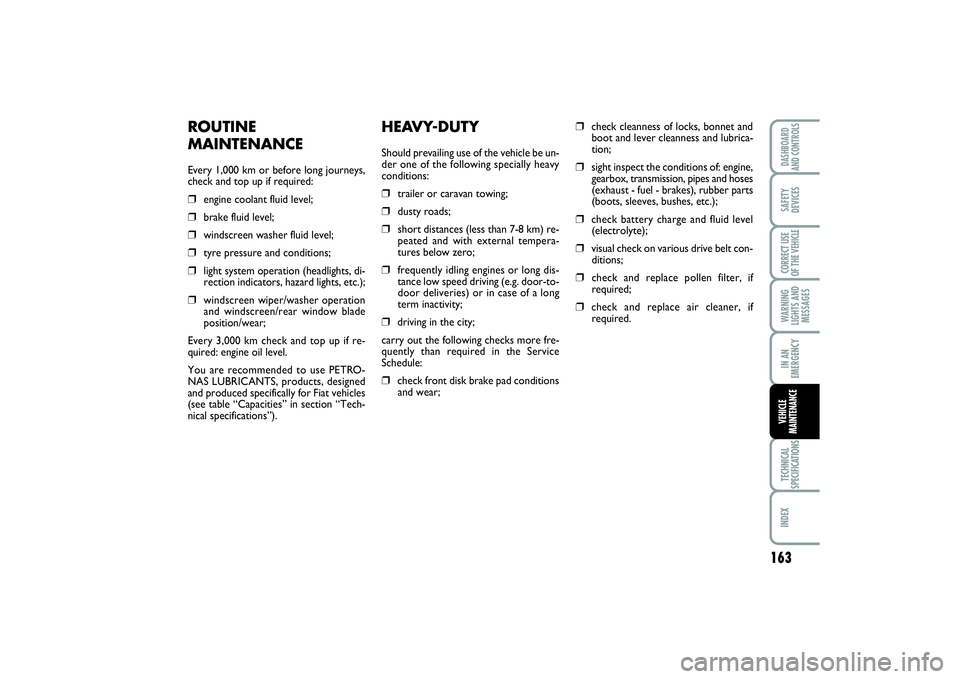
163
WARNING
LIGHTS AND
MESSAGESTECHNICAL
SPECIFICATIONSINDEX DASHBOARD
AND CONTROLSSAFETY
DEVICESCORRECT USE
OF THE VEHICLEIN AN
EMERGENCYVEHICLE
MAINTENANCE
HEAVY-DUTYShould prevailing use of the vehicle be un-
der one of the following specially heavy
conditions:❒
trailer or caravan towing;
❒
dusty roads;
❒
short distances (less than 7-8 km) re-
peated and with external tempera-
tures below zero;
❒
frequently idling engines or long dis-
tance low speed driving (e.g. door-to-
door deliveries) or in case of a long
term inactivity;
❒
driving in the city;
carry out the following checks more fre-
quently than required in the Service
Schedule:
❒
check front disk brake pad conditions
and wear;
❒
check cleanness of locks, bonnet and
boot and lever cleanness and lubrica-
tion;
❒
sight inspect the conditions of: engine,
gearbox, transmission, pipes and hoses
(exhaust - fuel - brakes), rubber parts
(boots, sleeves, bushes, etc.);
❒
check battery charge and fluid level
(electrolyte);
❒
visual check on various drive belt con-
ditions;
❒
check and replace pollen filter, if
required;
❒
check and replace air cleaner, if
required.
ROUTINE
MAINTENANCEEvery 1,000 km or before long journeys,
check and top up if required:❒
engine coolant fluid level;
❒
brake fluid level;
❒
windscreen washer fluid level;
❒
tyre pressure and conditions;
❒
light system operation (headlights, di-
rection indicators, hazard lights, etc.);
❒
windscreen wiper/washer operation
and windscreen/rear window blade
position/wear;
Every 3,000 km check and top up if re-
quired: engine oil level.
You are recommended to use PETRO-
NAS LUBRICANTS, products, designed
and produced specifically for Fiat vehicles
(see table “Capacities” in section “Tech-
nical specifications”).
159-178 SCUDO LUM GB 12/12/13 10.02 Pagina 163
Page 178 of 227
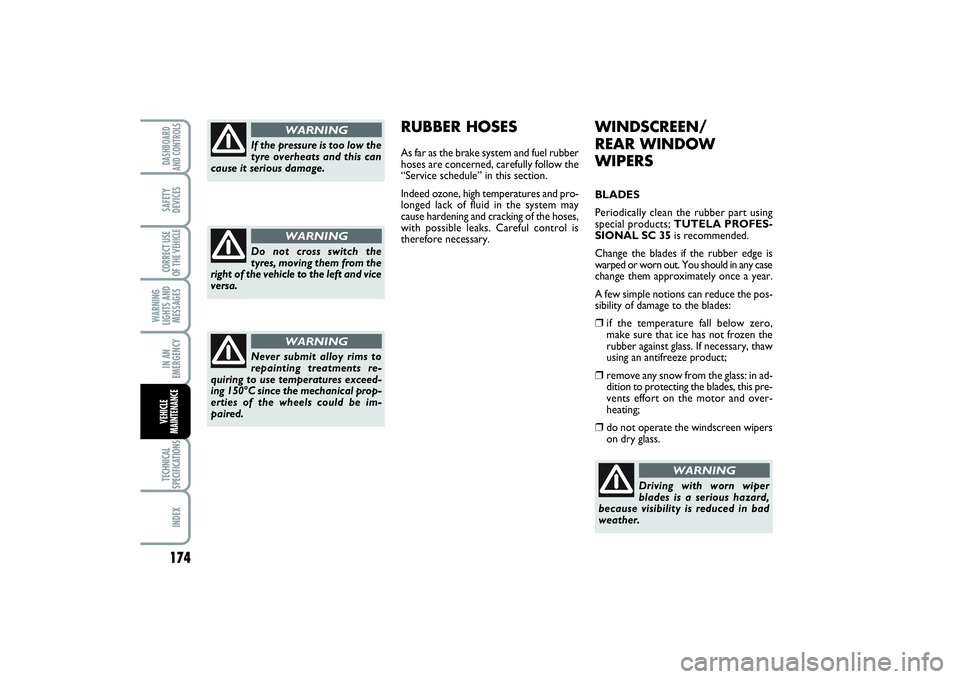
174WARNING
LIGHTS AND
MESSAGESTECHNICAL
SPECIFICATIONSINDEXDASHBOARD
AND CONTROLSSAFETY
DEVICESCORRECT USE
OF THE VEHICLEIN AN
EMERGENCYVEHICLE
MAINTENANCE
WINDSCREEN/
REAR WINDOW
WIPERSBLADES
Periodically clean the rubber part using
special products; TUTELA PROFES-
SIONAL SC 35is recommended.
Change the blades if the rubber edge is
warped or worn out. You should in any case
change them approximately once a year.
A few simple notions can reduce the pos-
sibility of damage to the blades:❒
if the temperature fall below zero,
make sure that ice has not frozen the
rubber against glass. If necessary, thaw
using an antifreeze product;
❒
remove any snow from the glass: in ad-
dition to protecting the blades, this pre-
vents effort on the motor and over-
heating;
❒
do not operate the windscreen wipers
on dry glass.
Driving with worn wiper
blades is a serious hazard,
because visibility is reduced in bad
weather.
WARNING
RUBBER HOSESAs far as the brake system and fuel rubber
hoses are concerned, carefully follow the
“Service schedule” in this section.
Indeed ozone, high temperatures and pro-
longed lack of fluid in the system may
cause hardening and cracking of the hoses,
with possible leaks. Careful control is
therefore necessary.
If the pressure is too low the
tyre overheats and this can
cause it serious damage.
WARNING
Do not cross switch the
tyres, moving them from the
right of the vehicle to the left and vice
versa.
WARNING
Never submit alloy rims to
repainting treatments re-
quiring to use temperatures exceed-
ing 150°C since the mechanical prop-
erties of the wheels could be im-
paired.
WARNING
159-178 SCUDO LUM GB 12/12/13 10.02 Pagina 174
Page 226 of 227
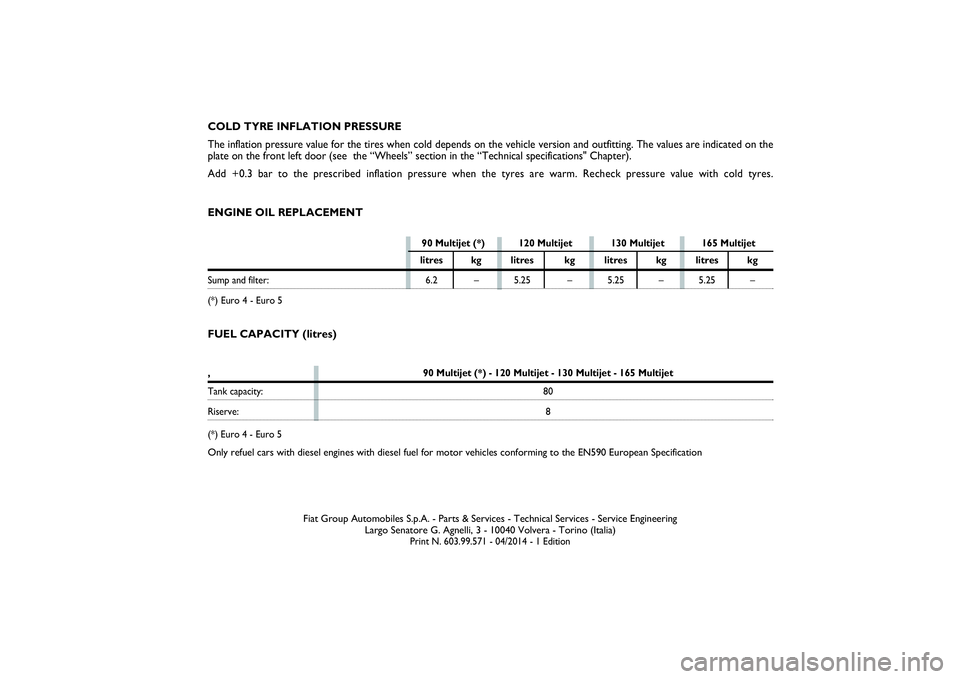
Fiat Group Automobiles S.p.A. - Parts & Services - Technical Services - Service Engineering
Largo Senatore G. Agnelli, 3 - 10040 Volvera - Torino (Italia)
Print N. 603.99.571 - 04/2014 - 1 Edition
ENGINE OIL REPLACEMENT
FUEL CAPACITY (litres) COLD TYRE INFLATION PRESSURE
The inflation pressure value for the tires when cold depends on the vehicle version and outfitting. The values are indicated on the
plate on the front left door (see the “Wheels” section in the “Technical specifications" Chapter).
Add +0.3 bar to the prescribed inflation pressure when the tyres are warm. Recheck pressure value with cold tyres., 90 Multijet (*) - 120 Multijet - 130 Multijet - 165 MultijetTank capacity: 80Riserve: 8
(*) Euro 4 - Euro 5Only refuel cars with diesel engines with diesel fuel for motor vehicles conforming to the EN590 European Specification
90 Multijet (*) 120 Multijet 130 Multijet 165 Multijetlitres kg litres kg litres kg litres kg
Sump and filter: 6.2 – 5.25 – 5.25 – 5.25 –
(*) Euro 4 - Euro 5
215-222 SCUDO LUM GB 08/04/14 14:22 Pagina 222